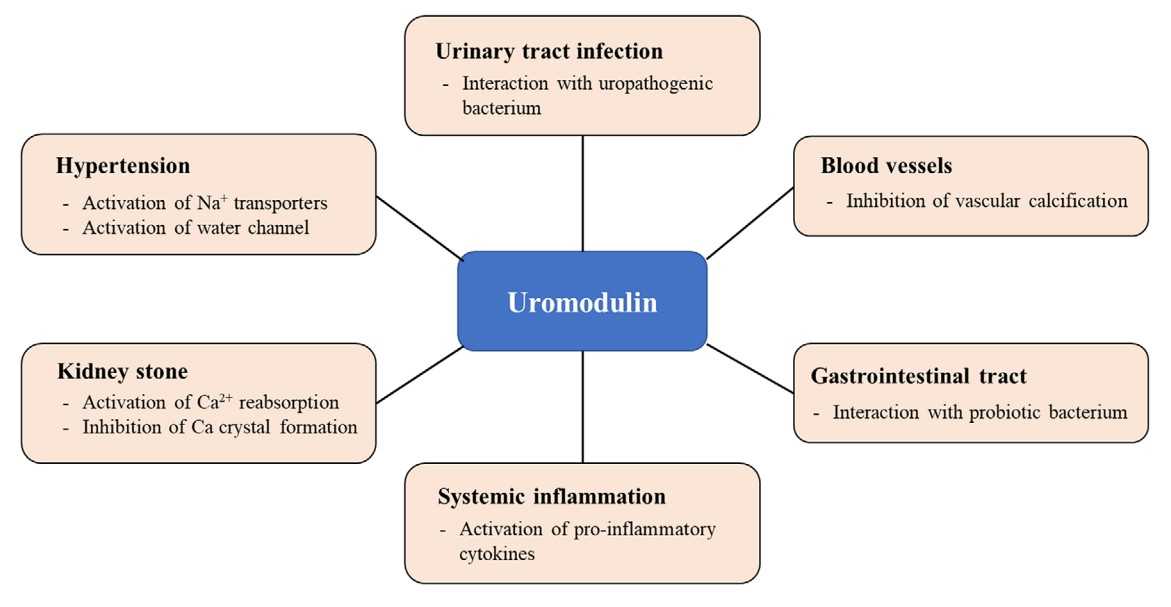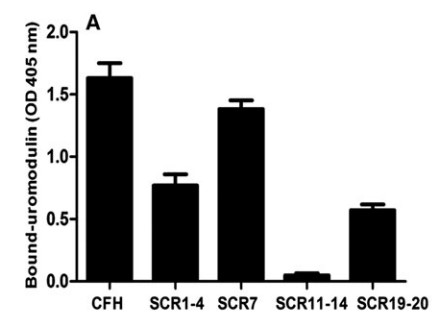UMOD
-
Official Full Name
uromodulin -
Overview
The Tamm-Horsfall glycoprotein (THP) also known as uromodulin is a glycoprotein that in humans is encoded by the UMOD gene.[1][2] Uromodulin is the most abundant protein in normal urine. -
Synonyms
UMOD;uromodulin;THP;FJHN;HNFJ;THGP;HNFJ1;MCKD2;ADMCKD2
Recombinant Proteins
- Mouse
- Human
- Rat
- Dog
- Pig
- E.coli
- Mammalian Cell
- Human Urine
- HEK293T
- Mammalian cells
- HEK293
- Yeast
- Porcine Urine
- His&GST
- GST
- His
- Non
- Myc&DDK
- Flag
- His&Fc&Avi
Background
What is UMOD protein?
UMOD (uromodulin) gene is a protein coding gene which situated on the long arm of chromosome 16 at locus 16p12. The protein encoded by this gene is the most abundant protein in mammalian urine under physiological conditions. Its excretion in urine follows proteolytic cleavage of the ectodomain of its glycosyl phosphatidylinosital-anchored counterpart that is situated on the luminal cell surface of the loop of Henle. This protein may act as a constitutive inhibitor of calcium crystallization in renal fluids. Excretion of this protein in urine may provide defense against urinary tract infections caused by uropathogenic bacteria. The UMOD protein is consisted of 640 amino acids and its molecular mass is approximately 69.8 kDa.
What is the function of UMOD protein?
UMOD protein, also known as uromodulin or Tamm-Horsfall protein, is the most abundant protein in normal human urine and is exclusively produced in the kidney by the epithelial cells lining the thick ascending limb (TAL) of the loop of Henle. UMOD is believed to play a role in water and electrolyte balance within the kidney. UMOD has been suggested to be involved in the innate immunity of the kidney. Recent evidence suggests that UMOD regulates the activity of the renal outer medullary potassium (ROMK) channel and the sodium–potassium–chloride (NKCC2) transporter, which are involved in NaCl reabsorption by the TAL segment.

Fig1. Local and systemic roles of uromodulin. (Tomoaki Takata, 2024)
UMOD Related Signaling Pathway
UMOD has been suggested to play a role in innate immunity and inflammation within the kidney. It can activate myeloid dendritic cells via Toll-like receptor 4 (TLR4), triggering them to reach a fully mature phenotype, which is part of the immune response. UMOD has been implicated in the pathogenesis of renal fibrosis. It is believed to influence the activation of profibrotic factors and the synthesis of extracellular matrix (ECM) components, which contribute to the progression of renal diseases.
UMOD Related Diseases
UMOD, or uromodulin, is a protein that is predominantly expressed in the kidney and is the most abundant protein in normal human urine. Mutations or variations in the UMOD gene have been associated with several diseases, primarily affecting renal function. Medullary Cystic Kidney Disease Type 2 (MCKD2) is a hereditary kidney disorder characterized by the development of cysts in the renal medulla. Familial Juvenile Hyperuricemic Nephropathy (FJHN) is a rare genetic disorder that presents with high levels of uric acid in the blood (hyperuricemia) and kidney damage, often leading to kidney failure. Since UMOD is related to uric acid handling in the kidney, mutations in this gene can also contribute to the development of gout, which is characterized by deposits of uric acid crystals in the joints.
Bioapplications of UMOD
UMOD has been studied as a potential biomarker for various kidney diseases, including chronic kidney disease (CKD) and acute kidney injury (AKI). Its levels in urine and serum have been found to correlate with the severity and progression of kidney diseases. UMOD levels may also have implications for the assessment of kidney transplant recipients, potentially serving as an indicator of graft health and function. UMOD's potential as a biomarker could lead to the development of diagnostic tests to identify and monitor kidney diseases, including those with a genetic component.
Case Study
Case Study 1: Lufeng Bai, 2021
Uromodulin (UMOD) can bind complement factor H (cFH) and inhibit the activation of complement alternative pathway (AP) by enhancing the cofactor activity of cFH on degeneration of C3b. UMOD, an N-glycans-rich glycoprotein, is expressed in thick ascending limb of Henle's loop where the epithelia need to adapt to gradient change of pH and ion concentration. ELISA-based cofactor activity of cFH and erythrocytes haemolytic assay was used to measure the impact of native and de-glycosylated UMOD on the functions of cFH. The binding assay was performed under different pH and ion concentrations, using ELISA. The levels of sialic acid on UMOD, from healthy controls and patients with chronic kidney disease (CKD), were also detected by lectin-ELISA. It was shown that removal of glycans decreased the binding between UMOD and cFH and abolished the ability of enhancing C3b degradation. In acidic condition, the binding became stronger, but it reduced as sodium concentration increased. A significant decrease of α-2,3 sialic acids on UMOD was observed in CKD patients compared with that of healthy individuals. The sialic acids on UMOD, local pH and sodium concentration could impact the binding capacity between UMOD and cFH and thus regulate the activation of complement AP.

Fig1. Uromodulin (UMOD)-cFH enhanced the prevention of the Sheep erythrocytes from haemolysis.

Fig2. Western blotting of UMOD which was treated with PNGase F and neuraminidase A.
Case Study 2: Maojing Liu, 2016
Recent studies suggest that uromodulin plays an important role in chronic kidney diseases. It can interact with several complement components, various cytokines and immune system cells. Complement factor H (CFH), as a regulator of the complement alternative pathway, is also associated with various renal diseases. Thus, the researchers have been suggested that uromodulin regulates complement activation by interacting with CFH during tubulointerstitial injury. They detected co-localization of uromodulin and CFH in the renal tubules by using immunofluorescence. Next, they confirmed the binding of uromodulin with CFH in vitro and found that the affinity constant (KD ) of uromodulin binding to CFH was 4.07 × 10(-6) M based on surface plasmon resonance results. The binding sites on CFH were defined as the short consensus repeat (SCR) units SCR1-4, SCR7 and SCR19-20. The uromodulin-CFH interaction enhanced the cofactor activity of CFH for factor I-mediated cleavage of C3b to iC3b.

Fig3. Competitive inhibition assay of UMOD–CFH binding.

Fig4. Mapping of UMOD–CFH interaction sites on CFH.
Quality Guarantee
High Purity
.jpg)
Fig1. SDS-PAGE (UMOD-37H)
.
.jpg)
Fig2. SDS-PAGE (UMOD-001H)
Involved Pathway
UMOD involved in several pathways and played different roles in them. We selected most pathways UMOD participated on our site, such as , which may be useful for your reference. Also, other proteins which involved in the same pathway with UMOD were listed below. Creative BioMart supplied nearly all the proteins listed, you can search them on our site.
| Pathway Name | Pathway Related Protein |
|---|
Protein Function
UMOD has several biochemical functions, for example, IgG binding,calcium ion binding. Some of the functions are cooperated with other proteins, some of the functions could acted by UMOD itself. We selected most functions UMOD had, and list some proteins which have the same functions with UMOD. You can find most of the proteins on our site.
| Function | Related Protein |
|---|---|
| IgG binding | FCGR1B,FCGR2A,FCGR1A,CD247L,FCGR3A,FCER1G,PIP,FCGR3B,FCGR2C,FCGR1 |
| calcium ion binding | PCDHGB3,PCDHGC5,PLCD3A,PPP2R3A,TMEM8C,NID1,MYL2B,PCDHB11,MACF1,CAPN2L |
Interacting Protein
UMOD has direct interactions with proteins and molecules. Those interactions were detected by several methods such as yeast two hybrid, co-IP, pull-down and so on. We selected proteins and molecules interacted with UMOD here. Most of them are supplied by our site. Hope this information will be useful for your research of UMOD.
ycgG;q81t34_bacan
Resources
Related Services
Related Products
References



